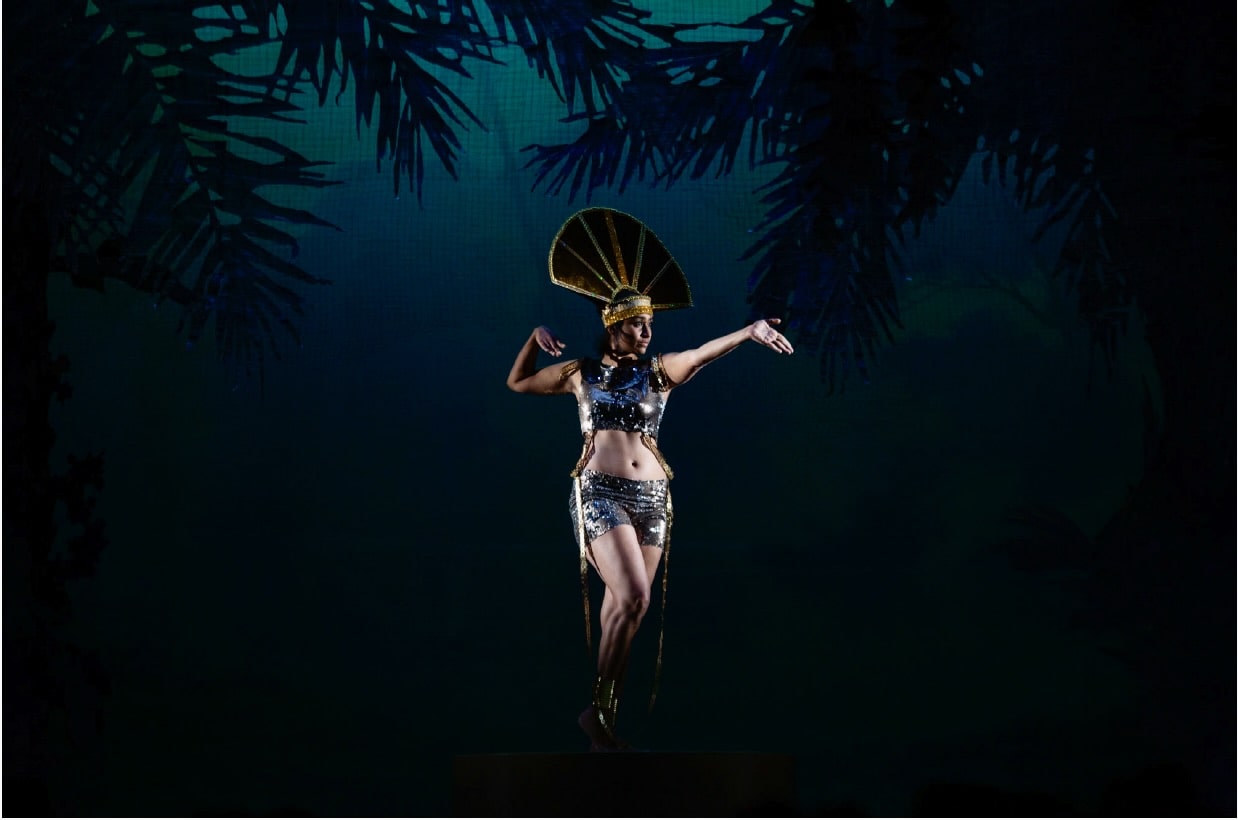


Amanda Piña, EXOTICA, 2023. Performance at Kunstenfestivaldesarts, Brussels, 2023. Courtesy of the artist. Photos by Tammo Walter.
EXÓTICA - On the brown history of European Dance
In the early 1900s, numerous talented dancers and choreographers of color, from diverse backgrounds, made their mark in Europe. However, many have since faded from memory, primarily because they didn't fit the traditional Western archetype or embody a specific European culture. In "Exotica," choreographer Amanda Piña honors these artists, shining a light on what she describes as the "brown history" of European dance.
Among these artists were La Sarabia (1878-1988), Nyota Inyoka (1896-1971), François “Féral” Benga (1906–1957), and Leyla Bedir Khan (1903-1986). They all enthralled European audiences with their mesmerizing performances. What did their work look like at their peak? How does it remain relevant today? Furthermore, what traces of their artistry can still be seen in contemporary dance throughout Europe and elsewhere?
"Exotica" isn't just a dance performance; it's a profound, soul-stirring ritual. Imagined as a séance, it brings back these pioneering dancers—both queer and women of color—from the annals of history. They "re-emerge" on stage, bridging historical gaps and engaging modern audiences. Through their performances, the stage becomes a space for reenactments, invocations, celebrations, and even exorcisms.
“Through this piece, I yearn to forge a connection with my roots—the women and queer artists of color who thrived in Europe in the early 20th Century. I aspire to bring them back into the spotlight, acknowledging and understanding their significant contributions. This journey goes beyond mere performance; it's a spiritual exploration. We delve into probing 'whiteness' beyond its hue, recognizing it as a pervasive belief system.” - Amanda Piña.
Among these artists were La Sarabia (1878-1988), Nyota Inyoka (1896-1971), François “Féral” Benga (1906–1957), and Leyla Bedir Khan (1903-1986). They all enthralled European audiences with their mesmerizing performances. What did their work look like at their peak? How does it remain relevant today? Furthermore, what traces of their artistry can still be seen in contemporary dance throughout Europe and elsewhere?
"Exotica" isn't just a dance performance; it's a profound, soul-stirring ritual. Imagined as a séance, it brings back these pioneering dancers—both queer and women of color—from the annals of history. They "re-emerge" on stage, bridging historical gaps and engaging modern audiences. Through their performances, the stage becomes a space for reenactments, invocations, celebrations, and even exorcisms.
“Through this piece, I yearn to forge a connection with my roots—the women and queer artists of color who thrived in Europe in the early 20th Century. I aspire to bring them back into the spotlight, acknowledging and understanding their significant contributions. This journey goes beyond mere performance; it's a spiritual exploration. We delve into probing 'whiteness' beyond its hue, recognizing it as a pervasive belief system.” - Amanda Piña.
CREDITS
Artistic Direction
Amanda Piña
Dramaturgy
Nicole Haitzinger
Performed by
Ángela Muñoz Martínez
Kabangu Bakambay André
Juan Carlos Palma
Venuri Perera
iSaAc Espinoza Hidrobo
Amanda Piña
Stage Set, Scenography
Jozef Wouters („Forêt Asiatique” (1921) by Albert Dubosq, reproduced as part of Infini #18 (2022)
Integral Design
Michiel Jimenez
Costume Design
Frederico Protto
Music
Ángela Muñoz Martínez, Zevra
Technical Director
Santiago Doljanin
Assistant Director
Pierre-Louis Kerbart
Production
Studio Fortuna
Co-production
Kunstenfestivaldesarts, Holland Festival, Festival d’Automne à Paris, Tanzquartier Wien, PACT Zollverein, DDD – Festival Dias da Dança, La Bâtie-Festival de Genève, NEXT Festival
Distribution
Something Great
Supported by
De Singel, KWP Kunstenwerkplaats, wpZimmer
Funded by the Cultural Department of the City of Vienna, Arts and Culture Division of the Federal Chancellery of Austria